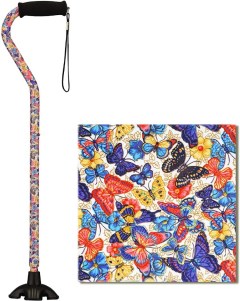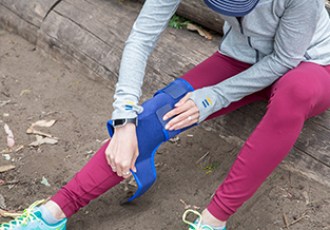BestReviews is reader-supported and may earn an affiliate commission. Details

Available in a variety of fun and stylish colors and patterns.
Available in a variety of fun and stylish colors and patterns.
Sturdy base helps with traction and control. Unique design takes the pressure off of wrists while the handle provides a padded, comfortable feel. Adjustable to offer different heights and has an anti-rattle lock to prevent rattling while in use. Comes with a 300-pound weight capacity
Even at the highest setting, may not work well for very tall people.

This ultra-stable option features a small, steady foot rather than a large 4-inch base.
This ultra-stable option features a small, steady foot rather than a large 4-inch base.
Ergonomic and shock-absorbing cushion top provides a comfortable feel. Adjustable height accommodates most people between 5 feet and 6 feet 6 inches tall. Lighter and more compact than a large-base model. Re-centers itself for maximum stability, allowing it to stand independently and support up to 300 pounds.
Outer ring can slide on linoleum.

Those with pain in joints like wrists, elbows, and shoulders may prefer this design's flatter, wider handle.
Those with pain in joints like wrists, elbows, and shoulders may prefer this design's flatter, wider handle.
Featuring flared rubber tips for stability and traction, a flatter, padded handle, and grip, this also adjusts from 29 to 38 inches. Has 11 push-button height adjustments to fit most people from 5 feet and 6 feet 5 inches tall. K-shaped base for stability is welded on for strength and has a weight limit of 300 pounds.
Not as lightweight as a pod-style model.

Pivot head helps keep the rubber feet tips from slipping when pushed to walk forward.
Pivot head helps keep the rubber feet tips from slipping when pushed to walk forward.
Innovative SteadiGrip stabilizing technology increases traction and improves balance both indoors and outdoors. Pivoting tripod base gives you a point of contact with it at all times. Can be folded to a handy length of 13.7 inches and supports up to 350 pounds.
Does not stand up well on its own.

With its built-in LED headlight, this cane works well for anyone who could benefit from additional light while walking.
With its built-in LED headlight, this cane works well for anyone who could benefit from additional light while walking.
The pivot base has 4 supportive pads and the ability to turn 360 degrees for increased traction and flexibility of use. Has 5 height adjustment options and a soft handle with a wrist strap. The cane’s shaft is made with aluminum. Can be folded.
Some customers wished that the cane's lightweight feel was more sturdy. The built-in light can be finicky.

We recommend these products based on an intensive research process that's designed to cut through the noise and find the top products in this space. Guided by experts, we spend hours looking into the factors that matter, to bring you these selections.

Many individuals look for a cane to help when regaining stability after surgery or experiencing other balance challenges. Unfortunately, standard canes may actually increase their risk of falling. Studies show that a quad cane is a better choice for those who need help with balance and stability.
Quad canes resemble standard canes in terms of shape, but they have four small feet instead of one larger tip. The extra feet spread the user’s weight over a larger area, providing a larger base of support than a standard cane and keeping the user more balanced as they walk. Many quad canes are so well balanced that they can stand up by themselves. This is an advantage for users, who can risk falling when attempting to pick up a standard cane that has slipped to the floor.
A cane can be a powerful tool that improves the user’s lifestyle, but using and choosing a cane are very personal decisions. The best cane for you is the one you’ll actually use.

True quad canes: These canes have four large feet that are several inches long. This gives the user a wide base of support. If stability is your biggest concern, this should be your first choice, but quad canes are not without drawbacks. The larger feet add to the cane’s weight; making it heavier than other options. Some quad canes may have too wide a base to be used on stairs. Also, the larger feet can pose a trip hazard or get caught on stationary objects.
If you think all canes are ambidextrous, you’re probably not a lefty. Many tools are designed for right-handed people since most people are right-handed. Canes are no exception, but this is not an area where you can afford to compromise. Canes are designed with features and angles to improve balance and may not do their job if used with the wrong hand. If you’re a southpaw, look for a cane that is specifically labeled as reversible or designed with lefties in mind.
There are many tips for choosing the right cane height: seeing that your elbow is bent about 15° when you hold the cane, or measuring from the floor to the crease of your wrist. But these methods aren’t always foolproof, and a cane that’s too tall or too short can jeopardize your balance further. Adjustable canes can remove the guesswork and let you experiment and find the best length for your posture and gait. Many canes can adjust from 28 inches to 38 inches, appropriate for users 5’0” to 6’5” tall.
Quad canes are intended to redistribute the user’s weight, but canes are designed to support a certain amount of weight. If you weigh more than the cane’s intended weight limit, it may not support you if you lose your balance. Most quad canes have a weight limit of 250 to 300 pounds. Check to make sure the cane you choose can give you the support you need, and look at bariatric models if necessary.
It’s not unusual for someone who has balance challenges to have pain in their joints. Users with a wrist brace might want to choose an offset cane or a model with a horizontal handle. These design elements can help redistribute body weight or reduce pressure on the joints of the hand and wrist without sacrificing stability.

A quad cane’s feet aid stability, but only if they don’t slip. Look for feet with rubber tips to help keep a grip when walking on slick surfaces.
Some canes have a base that pivots slightly to help the user adjust to the terrain. A pivoting base gives you more traction and allows you to adjust your posture without losing your balance or moving the whole cane.
Foldable: Keeping your balance is critical when you’re traveling and away from familiar places and doctors, but quad canes can be bulky, particularly the base. Some quad canes can be collapsed to fit in a suitcase, purse, or compact vehicle.
Wrist strap: Bending to pick up a fallen cane can jeopardize your balance. A wrist strap can make sure you don’t lose your cane even if you lose your grip on the handle.
Lights: Many falls happen in dimly lit areas where steps or uneven terrain can be hard to see. Some canes come equipped with lights that help illuminate dark corners, so you can see where you’re going and adjust.
No longer drab and dull, many quad canes come in a variety of vibrant colors and patterns. Not only can this brighten your mood, but it also makes it easier to pick out your cane from a group or spot it from a distance in a dim room.
Inexpensive: You can find basic quad-pod canes for under $25. Canes in this price range don’t come in fancy colors, but they should adjust to heights most individuals can use. Many have a weight limit of at least 250 pounds and may feature an offset handle to increase stability and reduce pain. They may also have rubber-tipped feet for stability.
Mid-range: These quad canes cost $25 to $30. You can find both full quad canes and quad-pod canes in this price range. They are adjustable in height and may support up to 300 pounds. You can find specialized grips that increase hand and wrist comfort and rubber-tipped feet for stability at this price.
Expensive: These quad canes cost $30 to $40. Both traditional quad canes and quad-pod canes in this price range are exceptionally stable. They’re adjustable, and many are built for users weighing up to 350 pounds. These quad canes help ward off joint pain with ergonomic, padded grips and an offset handle. They work for both righties and lefties and may include desirable features like LEDs and interesting colors.
Practice. Learning to walk with a quad cane takes practice. Give yourself plenty of time and be patient. If you’re getting a cane ahead of surgery, practice walking before your operation so you can face one fewer challenge as you recover.
Make sure that all four feet of your cane touch the floor as you step. If you don’t, you won’t get the full benefit of the cane’s support, and the cane may slip.

Q. In which hand should I hold a quad cane?
A. A quad cane is meant to compensate for instability in one of your legs. Hold the cane in the opposite hand of your weaker leg.
Q. How tall should my quad cane be?
A. Adjustable quad canes take the guesswork out of ordering, but you still need to set it up at home. It’s easiest to work with a partner who can observe you. Pick up your cane. Your arms should hang loosely at your sides, and the top of the cane should be about level with your wrist. Your shoulders should be even. If the shoulder of the arm holding the cane is higher than the other, the cane is too long. If the shoulder droops lower than the other shoulder, the cane is too short. A cane that’s adjusted correctly is a powerful tool, but one that’s poorly sized can lead to pain and further compromise your stability.
Q. Can I use a quad cane on stairs?
A. Yes, although it might take some time to master. When ascending steps, lead with your stronger leg. When descending steps, lead with the cane. Be patient, and give yourself as much time as you need to practice.
Get emails you’ll love.
Learn about the products you’re wondering if you should buy and get advice on using your latest purchases.
